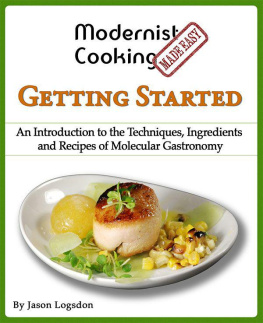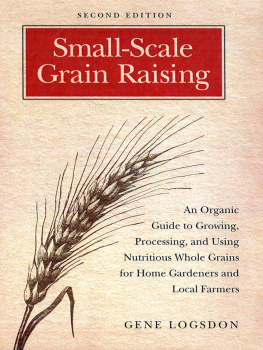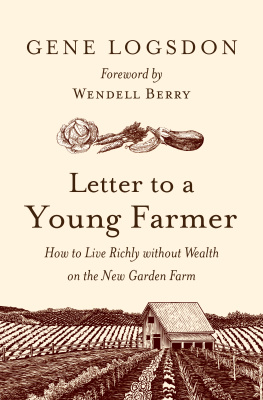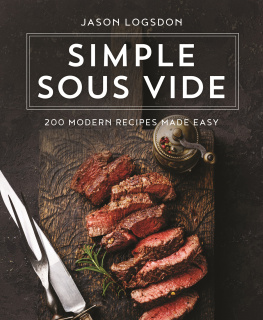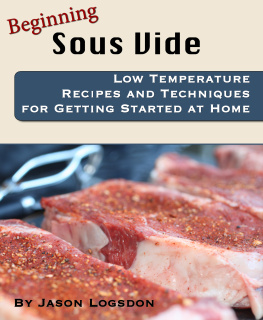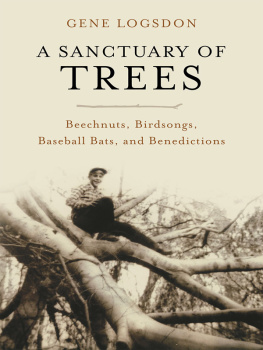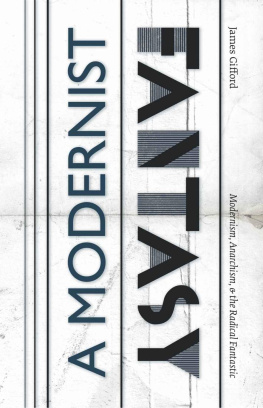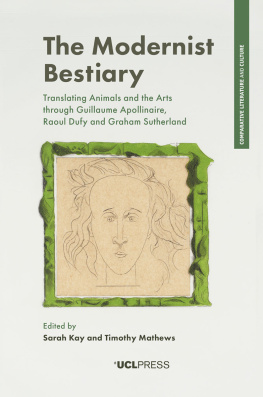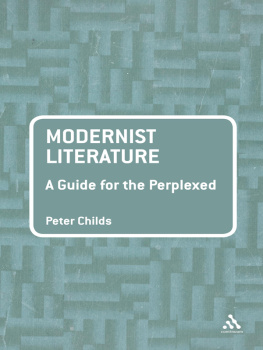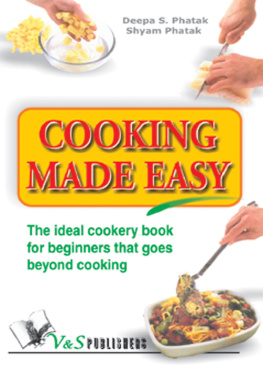Modernist Cooking Made Easy: Getting Started
An Introduction to the Techniques,
Ingredients and Recipes of
Molecular Gastronomy
By Jason Logsdon
Smashwords Edition
Copyright 2012 by Primolicious LLC
All rights reserved. Printed in the United States of America. No part of this book may be used or reproduced in any manner whatsoever without written permission except in the case of brief quotations embodied in critical articles and reviews.
For more information please contact Primolicious LLC at 12 Pimlico Road, Wolcott CT 06716.
ISBN-13: 978-1481063319
ISBN-10: 1481063316
For my wonderful wife,
who continues to support everything I do,
no matter how crazy.
Table of Contents
Section One
Introduction to Modernist Cooking
Acknowledgments
In cooking, most new dishes, flavors, and techniques are building on the work of prior generations of cooks. There are very few truly original works and we all owe a debt of gratitude to those that came before us and paved the way for us. There has been a great tradition of sharing and codifying cooking techniques from Escoffier to Ferran Adri to Grant Achatz to Nathan Myhrvold, each of which built on the works of those that came before.
This book is no exception. I could never have written it, much less explored the latest modernist techniques, without the chefs, authors, and cooks who experimented with food, and most importantly, shared their knowledge with us in books and on the internet.
Id especially like to mention several resources that were invaluable in creating this book. I highly recommend them for you to read if you want more in-depth knowledge.
Alinea by Grant Achatz is filled with amazing techniques and whimsical dishes. Aki Kamozawa and H. Alexander Talbot delve into the why in their Ideas in Food book, as well as their always informative website. Texture - A hydrocolloid recipe collection , compiled by Martin Lersch from Khymos.com, is a great compendium of recipes for many modernist ingredients. The Hydrocolloids Primer from Dave Arnold and the Cooking Issues website help to clarify some of the uses of and reasons for modernist ingredients . And, of course, the comprehensive Modernist Cuisine by Nathan Myhrvold, which covers pretty much every cooking technique you would ever need to know.
All of these resources gave me a foundation that I could use to explore the techniques and ingredients found in this book.
How To Use This Book
This book is meant to be used as both a reference guide and instruction manual for the new techniques and ingredients that are being used in modernist cooking. It has been written so each chapter can be used independently. I do recommend reading the Introduction to Modernist Cooking section first since it will provide you with a foundation of knowledge required to understand the remainder of the chapters.
After you have read the introduction chapters, there is no need to read the book straight through unless you want to. Feel free to jump around to any of the techniques or ingredients that interest you. If you seek additional information about a recipe you can look up the specific ingredients or techniques used in it to get a more detailed description of how they work.
We have provided images of many of the dishes. For larger, full color images you can go to:
www.modernistcookingmadeeasy.com/getting-started
To stay up to date with modernist cooking and what we are working on you can:
Join our monthly newsletter at: http://eepurl.com/owpNb
Follow me on twitter at: @jasonlogsdon_sv
Like our Facebook page at:
www.facebook.com/ModernistCookingMadeEasy
Most importantly of all, remember to have fun!
What is Modernist Cooking?

If you have any questions you can ask them in the Modernist Cooking Forums on our website. Just post your question and other cooks will weigh in with their answers.
You can find them on our website at:
www.modernistcookingmadeeasy.com/modernist-cooking-forums
Modernist cooking goes by many names including avant-garde, modernist cuisine, haute cuisine, and molecular gastronomy. In general, these terms really just mean any cooking that uses the most modern techniques. They tend to be associated with the more refined plating style and the use of esoteric ingredients but they really encompass all cooking knowledge.
The focus of this book is on the newer, modernist techniques and ingredients.
Are These Chemicals Safe?
One of the most common questions I get asked is some variation of are these chemicals safe or why do you use these chemicals? I prefer natural foods.
I have to be honest, these are also questions that I asked myself before I started embracing molecular gastronomy. When I began looking for answers, what I found was pretty amazing. These new chemicals are really no different than many of the ingredients we currently use in cooking and many of them have been around for a long, long time.
For instance, agar has been used in Asian cooking for hundreds of years and is just the extract from a certain type of algae. Xanthan gum is produced by fermenting sugar with a certain bacteria found in cabbage.
Unless you are on a raw or paleo diet, these ingredients are no more processed than kitchen stables you typically eat at home. Cornstarch (steeped, fermented, ground, washed, centrifuged, and dried corn) arent exactly pure, not to mention common ingredients like baking soda (sodium bicarbonate, a reaction of sodium chloride, ammonia, and carbon dioxide).
Im not a scientist or a nutritionist, but it seems to me if you bake, thicken liquids with cornstarch, or eat anything with sugar in it, then you shouldnt have any issues with using the majority of the modernist ingredients. Many of these modernist ingredients are also used in normal store-bought foods such as sandwich bread, mayonnaise, ice cream, and salad dressings and have been for decades.
Science or Cooking?
A major criticism of molecular gastronomy is that it is science not cooking, and that you need to understand chemistry and have lots of fancy equipment.
I think this viewpoint is mainly due to how recently many of these ingredients have started to be used in American kitchens. Because of this, there has been a lot of experimentation and explanation about how they work. All of this discussion took place for our traditional ingredients centuries ago, but these exact same discussions did occur.
For instance, you need to add water to the powdered mix and whisk until the thickening agent is evenly dispersed, becomes hydrated and a thick foam is formed, leavened by the carbon dioxide produced by the NaHCO interacting with the hydrogen. The foam is then heated over medium-high heat until the cellular foam structure solidifies and sets, and non-enzymatic browning covers the surface.
Or, you could say add water to the instant pancake mix, stir together, and cook until it isnt wet and the outside browns.
This same idea applies to molecular gastronomy too. To utilize the thickening power of xanthan gum you dont need to understand how it works on a molecular level, just that adding some to a liquid will cause it to thicken.
Im willing to bet that the majority of the people who say molecular gastronomy is too complicated can make instant pancake mix just fine but couldnt begin to tell you how it works.
Do I Need Lab Equipment?
Similar to the last point, many people picture fancy, expensive equipment in a sterile lab. The truth is that the majority of modernist cooking can be done with standard kitchen tools you already have on hand.
Next page
